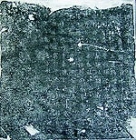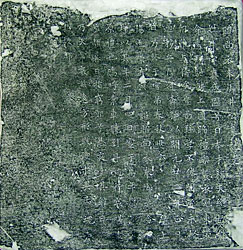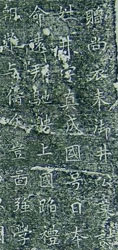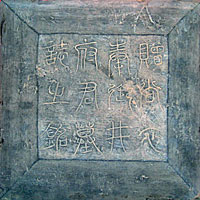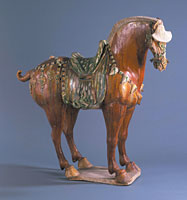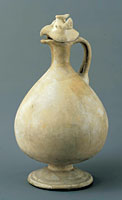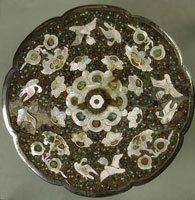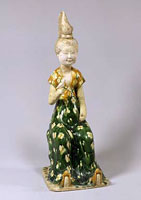Inscription of the Epitaph
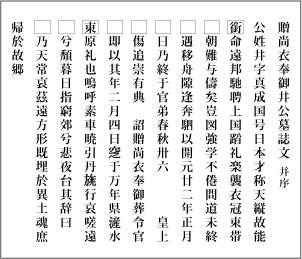 |
Translation
His family name was Jing, his given name Zhencheng, and his native country is known as Japan. He was gifted with outstanding ability. Commanded to join a mission to distant parts, he set forth enthusiastically for this country. He familiarized himself with Chinese manners and customs, and blended in well with Chinese society. In time, he became a court official; seen at court in his formal robes, he stood out even among those about him. He was diligent in his studies but - alas, who could have foreseen it? - he died suddenly and without warning before those studies could bear full fruit. He died on the (illegible) day of the first month of 734, at the age of 36. The emperor himself, grieving, pronounced the customary eulogy, issuing an imperial edict bestowing on him a high official rank, and had a funeral ceremony carried out at the court. He was buried on the fourth day of the second month of that year, in a grave in open country to the east of a river near Changan. A sad sight indeed - the red banners at dawn, raised in mourning over a funeral procession with a coffin drawn on a plain wooden carriage... Lonely in a distant land, he was to die at sunset and to grieve in a tomb in a desolate spot away from the capital. "To die," he seems to be saying, "is the will of Heaven, but more sad still is to die in a distant land. Though my body has been buried in foreign soil, may my soul return to the land that is my home." |
|
|
|
|
|
Lid of the Epitaph
H. 37.9cm, W. 37.3cm
Culture and Museology Department in Northwest University, China
Inscription of the Lid
 |
 |
| |
 |
 |
Note : The Envoys to Tang China |
|
 |
 |
Note : Epitaph Tablets in Ancient China |
|
| |
These official envoys were dispatched to Tang China over a period of two to two-and-a half centuries from 630 on, in order to study the culture and international situation of the continent. Some twenty voyages were planned, but in practice some of the crossings were never made, and there are various views as to how they should be counted. From the eighth century on, four vessels carried a total of approximately 500 persons on each voyage. Along with the crews went large numbers of scholar-monks, among them the celebrated Saicho (Dengyo Daishi) and Kukai (Kobo Daishi), lay students and technicians, who brought back the latest in continental culture to Japan. It appears that Jing Zhencheng joined one of these missions, which also included Abe no Nakamaro and Kibi no Makibi and the priest Genbo, at the age of 19 in 717. |
|
When a figure of high standing died in ancient China, it was customary to place in the tomb a stone tablet carved with information concerning his name, ancestors, official positions, family, and so on. The custom began in the late fifth century, under the Northern Wei dynasty, and the number discovered from the Tang dynasty, when they were produced in particularly large quantities, is approximately 6,500. Ranging from about 80-40 square centimeters in size, they were partly religious in nature - a certificate of social position for use in the next world, as it were - and partly a safeguard to make identification possible even if the tomb were rifled. With the ordinary official, it was usual for an account of his life to be submitted to the local office, which then had the inscription engraved. In the case of upper-grade officials, it seems that the engraving was usually entrusted to a well-known calligrapher. |
|
|
 |
 The Arts of the Tan Dynasty The Arts of the Tan Dynasty |
|
 |
|
|
|
Horse
Three-color glaze
H. 71.2 cm
Tang dynasty, 8th century
Tokyo National Museum |
|
|
|
Phoenix-head Ewer
White porcelain
Overall H. 28.1 cm
Tang dynasty, 7th century
Tokyo National Museum
(Important National Property) |
|
|
|
Plate in Shape of Peach
Vermeil with tortoise
H.1 cm, mouth D. 12.3 cm
Unearthed at Hejia village, Xi'an city, Shaanxi
Tang dynasty, 8th century
Shaanxi History Museum, China |
|
|
|
Dragons
Gold
H. 2.1 cm, L. 4.1 cm / H. 2.7 cm, L. 4.2 cm
Unearthed at Hejia village, Xi'an city, Shaanxi
Tang dynasty, 8th century
Shaanxi History Museum, China |
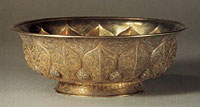 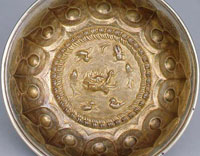
View of inside |
|
|
Bowl
Vermeil with mandarin ducks and fish in dragon pond
H. 5.2 cm, mouth D. 14 cm
Tang dynasty, 7th century
Hakutsuru Fine Art Museum, Hyogo
(Important Cultural Property) |
|
|
|
Mirror
Bronze with flowers and birds in mother-of-pearl inlay
D. 24.5 cm
Unearthed from the tomb of Li Cui in Xi'an University of technology
Tang dynasty, 8th century
Institute of Archaeology, Shaanxi Province, China |
|
|
|
Woman
Three-color glaze
H. 43.7 cm
Tang dynasty, 8th century
Tokyo National Museum |
|

